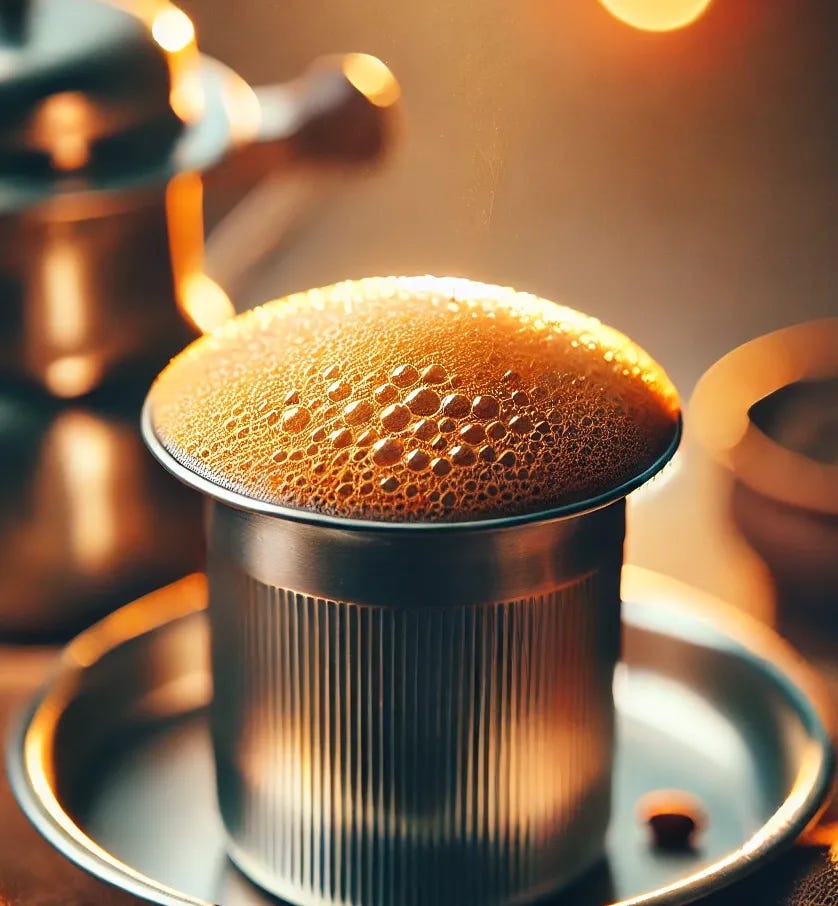The Paper Cup Crime: the Horror of Drinking Coffee Like Americans
the morning coffee, once a space for pause and connection, has been forcibly enlisted into the labor economy.
There are many sins in this world—ketchup on pasta, replying "lol" to long emotional texts, writing cringe LinkedIn posts as a "thought leader" unironically. But nothing is as tragic as the North American devotion to sipping burnt bean water from a flimsy, compostable-in-theory paper cup, as if caffeine is a medical necessity rather than a daily ritual worthy of reverence.
Growing up in India, coffee is served hot, strong, and foamed to within an inch of its life. It is served in a steel tumbler, not a landfill-bound abomination. Poured back and forth until it has texture (and soul), it is consumed slowly, under a ceiling fan, while discussing cricket, politics, or why your neighbor’s son is not married yet.
It is not meant to be gulped from a paper cup while half-heartedly scrolling emails. To-go coffee in India is as unnatural as eating a mango with a fork or respecting traffic lanes. You are required to pour it back and forth into a dabarah to cool it down, ensuring maximum froth and optimal drinking temperature.
You want coffee? You sit. You talk. You take your damn time.
And I know it is not unique to India. Having spent several months in France, it is laughable to even imagine a French person “grab a quick coffee” through a drive through! The French sit the f*ck down. Coffee in France is a ritual that requires small, controlled sips, dramatic pauses, and at least one sigh of existential despair.
Meanwhile, in America: The Competitive Sport of Coffee Consumption
American coffee culture is not about pleasure. It is about efficiency, endurance, and self-inflicted misery.
“I can’t function without my coffee!” (Drinks a liter of burnt bean water with six pumps of syrup.)
“I need my coffee fix!” (Chugs something called a "Trenta," which is actually just a bucket.)
“I drink three cups a day!” (Has been clinically dehydrated since 2016 but refuses to acknowledge it.)
The idea that coffee could be a small, joyful pause has been replaced by the belief that caffeine consumption must be maximized at all times. Americans drink coffee in their cars, on the subway, while running, while emailing, while frantically stuffing a protein bar into their face. If coffee is supposed to be a moment of peace, we have brutalized it into a high-speed, high-stress endurance test.
And it is not just about the speed. In Italy, for instance, coffee is consumed quickly and efficiently, BUT with respect. It is a two-minute affair at a bar, standing up, exchanging pleasantries with a man who has been making espresso since before you were born. It is not a commute beverage. If you try to walk down the street with a flimsy cardboard cup, Italians will assume one of three things:
You are filming a prank video.
You have suffered a personal tragedy and are no longer in control of your life.
You are American and beyond saving.
Coffee is meant to be savored, not inhaled. To be held, not carried. Sipped in stolen moments, not sloshed around in traffic. So next time you order coffee? Sit down. Stay awhile. Let the caffeine seep into your bones before you go charging back into the madness. Because if Italy, France, and India agree on something, it’s probably worth listening to.
And what, then, does this tell us about the society we have created?
The transformation of coffee from a communal, reflective act into a hyper-individualized, time-saving stimulant is not merely a matter of changing consumer preferences. It is a symptom of a larger ideological shift—one in which efficiency is valorized above all else, where every moment must be optimized for productivity, and where even the most mundane rituals of daily life are restructured to serve the economic machinery of the modern state.
The morning coffee, once a space for pause, and connection, has been forcibly enlisted into the labor economy. It is no longer an act of pleasure, but one of compliance—fuel for the worker, extracted at the lowest possible cost and consumed in transit. It is not incidental that in cultures where coffee remains a ritual, there exists a different relationship to time, labor, and power. The insistence on sitting, on conversing, on drinking from a real cup rather than a disposable shell, is not merely an aesthetic preference—it is an act of defiance against the commodification of every second of existence.
To refuse the paper cup is, in a small but significant way, to reject the ideology that dictates one must always be in motion, always consuming, always producing. It is to assert that time belongs to the individual, not to the market. But of course, capitalism has a way of absorbing all resistance into its framework, of turning even opposition into a monetizable asset.
And so, as we speak, some marketing executive in a glass-walled office is drafting a campaign to sell us “slow coffee”—a $9 pour-over, rebranded as an aspirational lifestyle product rather than the default state of being it once was. The very act of savoring time, of reclaiming the right to a moment unoptimized, will itself be packaged, sold, and made palatable to a system that cannot abide anything that does not serve its ends.





